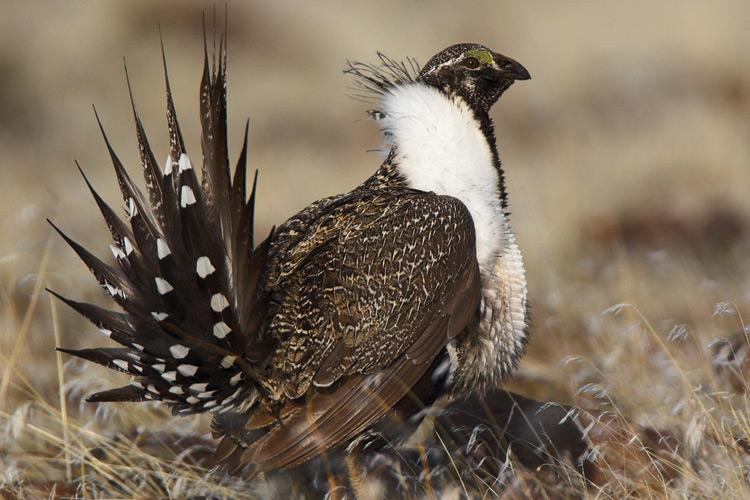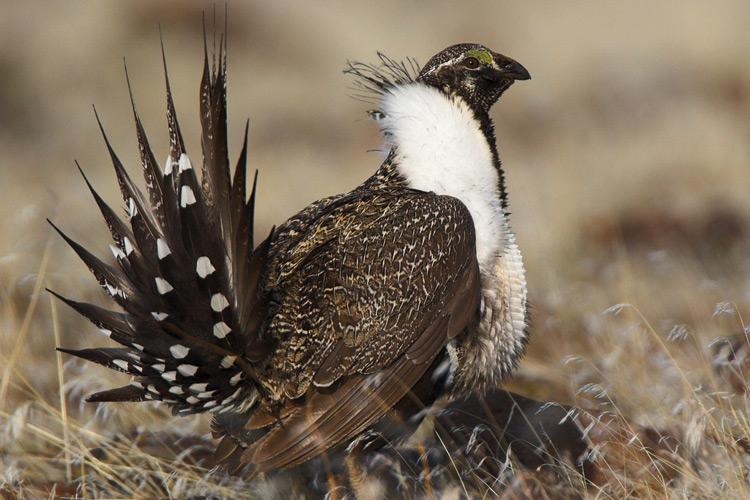

There’s been big effort to help the bird. Now, Garfield County officials are watching closely as the federal government decides how closely to protect a big chunk of its Colorado habitat. There’s disagreement about how to do that, and huge restrictions on private and public land are at stake if officials get it wrong. The Bureau of Land Management (BLM) is taking comments on its habitat plan for the Greater Sage-Grouse. The deadline is December 2nd.
Reporter Elise Thatcher, Aspen Public Radio: This is a story about birds, land development, and the government. Which can sound pretty dry. So here’s something to keep in mind. It involves a dancing and, well, sex. We’ll get to the sexy part in just a minute -- so keep that in mind. The bird in our story is the Greater Sage-Grouse. It’s been described as a big chicken. The males stand about two feet tall. They live in Colorado and Wyoming and other states across the west. As their name implies, these birds live in sagebrush and other high plains areas… habitat that has changed over the last fifty years. David Boyd is with the Bureau of Land Management.
David Boyd: “Increased vehicle traffic, increased human presence, increased noise seems to have a big impact on’em. And then just increased infrastructure, so as you’re going in and there’s drilling rigs or power lines. And that makes them really nervous.”
Reporter: While Colorado is an exception, the number of Greater Sage-Grouse has been dropping around the country. A big reason why is in how the birds find mates. As in, the only singles hook-up is in when big groups of grouse gather in the spring.
Reporter: As they have for generations, the Sage-Grouse always meet in the same spot… year after year… in these places they stage elaborate courtship dances. Kind of like anyone who has a favorite bar to check out the singles scene. For the grouse its much the same; when something new shows up and changes everything... like, say, a new oil drilling rig.
Reporter: Now they have to look for a new spot. Again, David Boyd ...
Boyd: “If there’s disturbance and it’s not working for them anymore, then they stop going to them.”
Reporter: So Greater Sage-Grouse can’t go back to their favorite place to meet special someone…And in a tragic twist, it’s difficult for the birds to find a new hot place to meet. Scientists aren’t sure why. Colorado has spent about forty million dollars, so far, trying to help the bird thrive. There’s a multi-state effort to get ranchers, landowners and other land users to work together to make life as easy possible for the Sage-Grouse. Enter the Federal Government. The Bureau of Land Management will decide how it’s going to manage much of the Greater Sage-Grouse habitat in Colorado that’s on public land. The BLM is considering restricting oil and gas development, ranching, and other activities. This worries some people.
Frank Daley: “My name’s Frank Daley, and we ranch on Divide Creek, south of Silt. Myself and my family. We also have a ranch on the north side of the River, North of New Castle.”
Reporter: He’s also the incoming president of the powerful Colorado Cattlemen’s Association. The cattlemen worry that in their efforts to save the grouse new restrictions on BLM land will hurt their livelihoods. Especially in Garfield County.
Daley: “We have sage brush around here but it’s interspersed with oak brush. When you get up a little higher there’s quakies and spruce and so forth. Not to mention the valleys where there’s more irrigated hay lands mixed in with the sagebrush. So this just doesn’t seem to be ideal sage grouse habitat.”
Reporter: About four hundred Greater Sage-Grouse live in the Garfield County area. And, while Garfield County officials agree the habitat isn’t ideal, they are ok with some new restrictions...in some specific areas. What they don’t want are blanket restrictions across big chunks of the county. Commissioner Tom Jankovsky says he doesn’t support the BLM’s preferred approach and argues Garfield County already has a plan for taking care of Greater Sage-Grouse habitat.
Commissioner Jankovsky: “On federal lands, within the priority of the habitat for the Greater Sage-Grouse, we have a no surface occupancy restriction. And then on private land we’ve asked for voluntary restrictions from the landowners.”
Reporter: For its part, the BLM says it might approve part of the Garfield County plan. The federal agency is taking a kind of mix and match approach – hoping to create a plan for Sage-Grouse habitat that helps the bird with a minimum impact on local businesses and jobs. Time is of the essence. Another federal agency must decide by 2015 whether the bird should be listed as endangered or threatened. If the bird is added to either, it would mean even harsher restrictions… to ensure the Greater Sage-Grouse has enough room to dance.
Copyright 2013 Aspen Public Radio. To see more, visit http://kajx.org/







